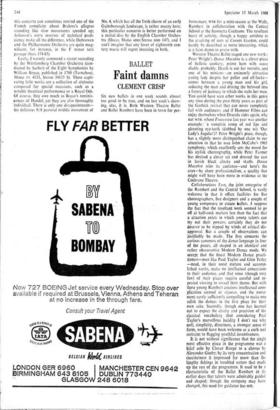Round and round
MUSIC & RECORDS EDWARD BOYLE
Ever since my boyhood I have admired Georg Szell as a conductor, and it was splendid to hear him and the London Symphony Orchestra in such magnificent form in their Mozart and Mahler concert at the Festival Hall last Wed- nesday. There have been a number of fine per- formances of the 'Jupiter' Symphony during this past year, but last Wednesday's was out- standing for its precision, beauty of string tone, vigour and rhythmic poise.
The Andante was particularly admirable: not too slow, so that one could feel the basic three- in-a-bar pulse; the soft triplets in the second half of the second subject played in steady time but without rigidity; and the dramatic passage near the start of the recapitulation working up to a fortissimo which never sounded exag,ger- ated or out of style. The minuet was brisk,
though not too fast for me (foi: the record, Szell'i tempo of 4' 45" was just over a full minute
faster than Beecham's in his 1958 recording).
The Finale was played very fast indeed, but then this wonderful movement is marked 'molto allegro' two-in-a-bar. There was no lack of clarity, the brass in particular responding splendidly, and I have never heard one all- important figure—down a third and then up a fourth—which plays such a great part in this movement, given such an impressive 'lift' in the stretto passages. This was a performance of a maturity which reminded one that Szell began his public career just over fifty years ago.
The second half of the programme consisted of Mahler's Das Knaben Wunderhorn songs, with Elisabeth Schwarzkopf and Dietrich Fischer-Dieskau as soloists. I do not think 1 have ever heard Fischer-Dieskau sing more superbly in the Festival Hall. and he shared his sensitive mastery of those wonderful songs from the very first number, `Revelge.' Schwarzkopf was not at her best to begin with, and she seemed understandably handicapped, in places, by the low pitch of the music. However, she recovered in time to join Fischer-Dieskau in a memorable performance of 'Der Schildwache Nachtlied,' and her high F on the last page, sounding against the orchestra as it reached up to its soft, unresolved dissonance, was one of the gems of the evening.
It was a bold but eminently right decision to end the evening with 'Wo die Schiinen Trom- peten Blasen,' perhaps the most intimate song in the entire cycle, performed on this occasion as a duet. One cannot easily do justice to the soft beauty of Fischer-Dieskau's tone in the liindler sections of this song, and praise is almost equally due to Szell for the perfect timing of his momentary crescendo, exactly as marked in the score, at the break between the lines 'Ich seh' die Morgenrot aufgeh'irl Die MorgenrOt zwei helle Stern.' And I have never before heard the independent rhythms of the voice and trum- pet parts so skilfully brought out at 'Die griine
Haide, die ist so weir'—throughout the final pages both singer and conductor perfectly con- veyed the sense of insistent reality gently but relentlessly breaking in on tenderness.
I'm glad that EMI, in their 'Great Instrumen- talists' series, should have devoted a disc to Egon Petri (HQM 1112), surely one of this cen-
tury's most underrated masters of the piano. His thirty-year-old recording of Beethoven's little F sharp major sonata. op 78, is the most beautiful I have heard, and still sounds remark- ably clear and full--much pleasanter. indeed, than his (American) Westminster recordings of Beethoven sonatas which were available for a short while in this country in the early 1960s. A Liszt group includes a stunning 1929 perfor- mance of Gnomenreigen (even more idiomatic, I feel, than Curzon's), and a number of Schubert transcriptions including Liebesbotschafr which, played like this, sounds irresistible; there is also a rare and valuable Busoni group. I'm only sorry there wasn't room, in addition, for Petri's immaculate old Columbia recording of the Brahms Paganini Variations; not normally a laudator ternporis acti where musical perfor- mances are concerned, I do feel that Petri, Horowitz and also Wfihrer, in their prime, gave finer performances of this particular work than we usually hear today.
I have also much enjoyed the reissue of the 1947 recording by Solomon and Issay Dobrowen of Brahms's Second Piano Concerto (limy XLP 30093), which shows both pianist and conductor at their best. The first movement of this concerto can sometimes remind one of the French complaint about Brahms's allegros sounding like slow movements speeded up; Solomon's extra reserves of technical profi- ciency make all the difference, while Dobrowen and the Philharmonic Orchestra are quite mag- nificent, for instance, in the F minor tutti passage (bars 174-85).
Lastly, I warmly commend a recent recording by the Wiirttemberg Chamber Orchestra (con- ducted by Saeber) of the Eight Symphonies by William Boyce, published in 1760 (Turnabout, Mono TV 4133, Stereo 34133 S). These capti- vating little works are a collection of sinfonias composed for special occasions, such as a notable theatrical performance or a Royal Ode. Of course, they owe much to Boyce's reminis- cences of Handel, yet they are also thoroughly individual. There is only one disappointment— the delicious 9/8 pastoral middle movement of No. 4, which has all the fresh charm of an early Gainsborough landscape, is rather muzzy here; this particular concerto is better performed on a recital disc by the English Chamber Orches- tra (Decca Mono ADD/Stereo SDD 147), and I can't imagine that any lover of eighteenth cen- tury music will regret investing in both.











































 Previous page
Previous page